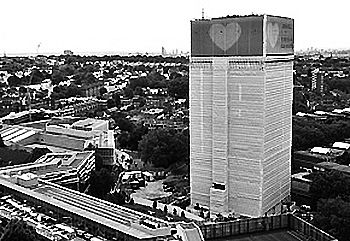Underwater foundations
Contents |
[edit] Introduction
Foundations can often be required for the construction of harbour walls, sea walls, breakwaters, and so on. Underwater foundations, also known as subaqueous foundations, may be used in situations where the use of a cofferdam or caisson is prohibitively expensive or unfeasible.
Typically, dredgers or grabs working from pontoons will excavate the ground and load the spoil into barges. If rock needs to be removed, drill and blast methods can be used, or drilling and cutting by jackhammer. Softer rock formations can be dredged or broken up by air tools and then grabbed. Gravel and sands can be excavated using a suction dredger or ejector tube.
Divers can then place temporary steel formwork, using sandbags to anchor them in place and prevent concrete leakage from under the toe of the form. If the foundation is relatively short and in shallow water, bagged concrete or cement placed in layers may be used as formwork and left in position. Foundations in deeper water may incorporate permanent formwork in the form of precast concrete blocks which are tied in to the foundation.
The concrete mix must have a high degree of workability to maintain a good flow and prevent too much cement being washed out of the mix. This ensures that the leading edge of the concrete is kept moving forward under the pressure of additional material. Extra cement should be added to offset any loss through the water, although too much cement will result in excessive laitance forming on the concrete surface.
[edit] Concrete placing
Concrete is generally placed by one of three methods:
[edit] Placing by tremie
A tremie is a steel tube suspended in the water from a crane. A hopper is fixed to the top end to receive the concrete. The tremie is positioned vertically over the area to be concreted with the lower end resting on the bottom. After the pipe has been filled with concrete it is raised off the bottom to allow it to flow. This should allow the flow to continue to feed the interior of the initial mass.
The flow rate of concrete is controlled by raising and lowering the tremie, but care must be taken not to lift the tremie out of the concrete mass, otherwise the seal will be broken and the concrete will be weakened by water as it rushes out of the pipe. This may result in a damaged surface to the mass of concrete which will need to be removed before work can recommence. One tremie will serve an area of approximately 30 sq. m, and where all the concrete cannot be placed from one position, more than one tremie can be used for simultaneous placing.
For more information, see Tremie.
[edit] Placing by skip
Bottom-opening skips can be used, which are fitted with a top cover held in position by water pressure. The skip is filled with concrete before being gently lowered into the water. On reaching the bottom, the skip is emptied.
If it is lowered too rapidly, the covers may be disturbed and the concrete inside damaged. This is a slower method than a tremie pipe but can be more practical for thin beds, whereas tremies are more appropriate for large pours.
[edit] Pumping
Concrete pumping is a method used when very large concrete pours are required.
Pipe lines typically have a diameter of 110-150 mm and are generally capable of pumping for a distance of 300 m horizontally and 30 m vertically. Pumps may be mounted on a pontoon with an extendable steel boom. The pump works hydraulically with a diesel-driven piston that forces concrete along the pipes.
[edit] Related articles on Designing Buildings Wiki
Featured articles and news
The UK's Modern Industrial Strategy: A 10 year plan
Previous consultation criticism, current key elements and general support with some persisting reservations.
Building Safety Regulator reforms
New roles, new staff and a new fast track service pave the way for a single construction regulator.
Architectural Technologist CPDs and Communications
CIAT CPD… and how you can do it!
Cooling centres and cool spaces
Managing extreme heat in cities by directing the public to places for heat stress relief and water sources.
Winter gardens: A brief history and warm variations
Extending the season with glass in different forms and terms.
Restoring Great Yarmouth's Winter Gardens
Transforming one of the least sustainable constructions imaginable.
Construction Skills Mission Board launch sector drive
Newly formed government and industry collaboration set strategy for recruiting an additional 100,000 construction workers a year.
New Architects Code comes into effect in September 2025
ARB Architects Code of Conduct and Practice available with ongoing consultation regarding guidance.
Welsh Skills Body (Medr) launches ambitious plan
The new skills body brings together funding and regulation of tertiary education and research for the devolved nation.
Paul Gandy FCIOB announced as next CIOB President
Former Tilbury Douglas CEO takes helm.
UK Infrastructure: A 10 Year Strategy. In brief with reactions
With the National Infrastructure and Service Transformation Authority (NISTA).
Ebenezer Howard: inventor of the garden city. Book review.
The Grenfell Tower fire, eight years on
A time to pause and reflect as Dubai tower block fire reported just before anniversary.
Airtightness Topic Guide BSRIA TG 27/2025
Explaining the basics of airtightness, what it is, why it's important, when it's required and how it's carried out.
Construction contract awards hit lowest point of 2025
Plummeting for second consecutive month, intensifying concerns for housing and infrastructure goals.
Understanding Mental Health in the Built Environment 2025
Examining the state of mental health in construction, shedding light on levels of stress, anxiety and depression.





















